Douglas C-33 / C-39
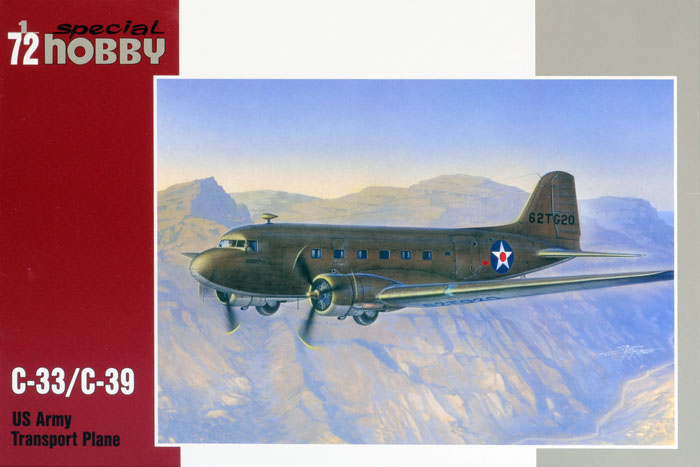
Special Hobby, 1/72
scale
S
u m m a r y |
| Catalogue Number: |
Special Hobby Kit No. SH72176 - Douglas C-33 /C-39 |
| Scale: |
1/72 |
| Contents and Media: |
79 parts arranged on two sprues of grey styrene; 21 parts in clear styrene; 1 resin part; a photo-etched fret; decals for four subjects. |
| Price: |
From £27.23 available online from Hannants
USD$63.00 available online from Squadron
|
| Review Type: |
FirstLook |
| Advantages: |
Beautifully detailed styrene parts; kit offers choice of parts to produce a range of DC-2 variants; excellent decals. |
| Disadvantages: |
Undercarriage bays lack detail; propellers are multi-piece with separate blades |
| Recommendation: |
Highly Recommended, but definitely not for the beginner |
Reviewed by
Peter Mitchell

Special Hobby's 1/72 scale C-33 / C-39 is available online from Squadron.com
In 1932, TWA set a challenge with five aviation companies with a requirement for a new modern transport aircraft. The Douglas solution was an advanced design of an all metal, low-wing cantilevere monoplane with retractable undercarriage and seating 12 passengers; the Douglas Commercial No 1 or DC-1.
This was a far cry from the Fokker and Ford Trimotors which prevailed at the time.
TWA settled on a modified version with a lengthened fuselage the capacity to carry 14 passengers and slightly more powerful Wright Cyclone engines.
And so the DC-2 was born.
TWA ordered 20, and soon other airlines bought the DC-2, including European customers KLM, Swissair and CSL (later CSA).
The DC-2 was the first true example of safe, reliable and comfortable passenger air travel over long distance routes. Some proof of this came when KLM entered their first DC-2 PH-AJU Uiver (Stork) in the October 1934 MacRoberson Air Race between London and Melbourne. Out of the 20 entrants, it finished second bettered only by de Havilland DH.88 racer Grosvenor House (The DH.88 was a the purpose built racer)
The DC-2 was also licensed built overseas, Nakajima produced it as the AT-2 / Ki-34
Airlines weren't the only user of the DC-2, it wasn't long before the USAAF, the US Navy and Marine Corps all operated examples of the DC-2.
Former civil DC-2s were often “pressed” into service; for instance in Spain they were converted into make shift bombers during the Spanish Civil War, and during world war two many were used as emergency transports by a variety of nations.
The first version of the DC-2 specifically developed for the military was the C -33 Cargo transport aircraft of which 18 were built. This had a hinged cargo door in the aft fuselage and DC-3 tail planes. This was soon followed by the C-39, a composite of the DC-2 with DC-3 central wing and tail components. 35 of these were produced. These two versions represent the transition between the two types and are the subject of this Special Hobby release.
There are about half a dozen or so DC-2s still existent around the world, at least two of these aircraft are in flying condition.
This kit is essentially a re-boxing of the original MPM 1/72 release of the DC-2, however it makes use of a few additional parts to make the C-33/C-39 Military transport versions.
The part sprues are all individually bagged and come in a sturdy, light-weight top opening box.
The kit is consists of 79 parts moulded in light grey styrene on four separate sprues. These are crisp mouldings, the parts have very finely engraved detail throughout and minimal flash. There are some minor ejector towers on the inside of the larger parts like the wing, tailplanes, fuselage and fin which will require removal. A separate clear sprue contains 21 transparent parts and these are nice and clear and free from distortion.
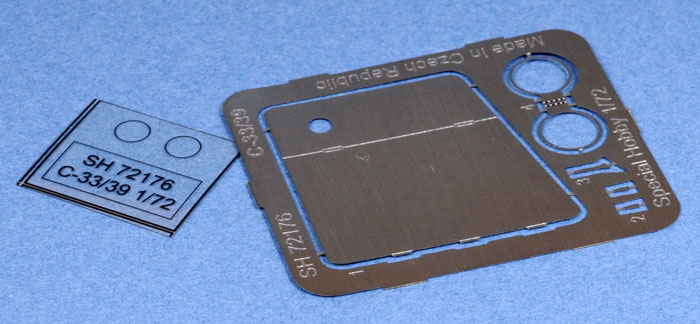
A small fret of photo-etch has 5 parts (the majority concerning the cargo doors) and the only resin included is the tear-drop D/F loop casing. As with the short run nature of this kit, there are no locating pins or tabs to assist with the attachment and alignment of part, so care will be required in the construction.
The instructions are thorough but busy and will require careful scrutiny as construction progresses. Special-Hobby provide Gunze-Sanyo paint codes for the colours.
The kit supplies parts for a decent cockpit and interior; consisting of floor, a pair of control yokes, seats, instrument panel and bulkheads for the cockpit. This is attached to a long cabin section that is made up of a plain floor and two bulkheads, which should be adequate given this a cargo version. All the windows along the fuselage sides are made up of individual panes, so great care will be required when putting them in place.
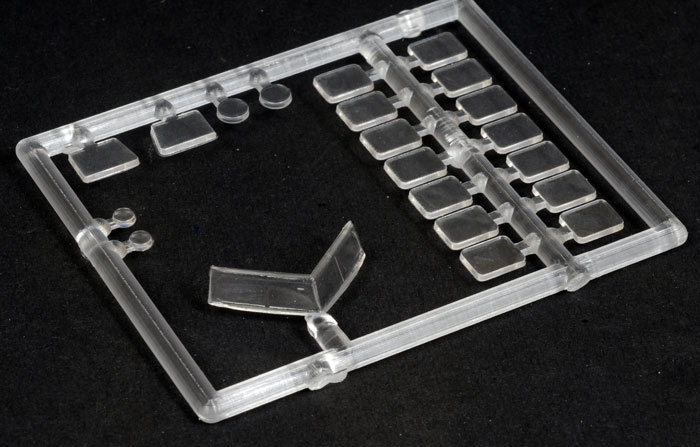
The main wings are separated into five sections with an optional style centre underwing/lower fuselage portion and then lower and upper halves all of which are butt joined to each other and subsequently to the fuselage. To achieve the correct dihedral may prove to be a difficult process and the modeller will perhaps need to add strengthening tabs here.
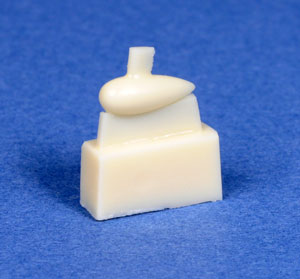 The engine nacelles have an insert for the roof of the undercarriage bays, however these carry no detail other than cut outs for the wheels. Both the DC-2 and DC-3 styles of tail plane and vertical fin/rudder are included, the C-33 uses the DC-3 tail planes only, while the C-39 uses both the tail plane and vertical fin/rudder of the DC-3. These simply butt join to the fuselage and like the wings will more than likely benefit from strengthening pins. Two styles of noses are also provided, one with landing lights and one without; the C-33 uses the former while the C-39 uses the later. For the engines, the modeller is provided with some well detailed engine fronts on a fire-wall disc rather than a full engine. These should prove to be quite adequate for the job and simply fit into the back of a nicely rendered one-piece nacelle. The engine nacelles have an insert for the roof of the undercarriage bays, however these carry no detail other than cut outs for the wheels. Both the DC-2 and DC-3 styles of tail plane and vertical fin/rudder are included, the C-33 uses the DC-3 tail planes only, while the C-39 uses both the tail plane and vertical fin/rudder of the DC-3. These simply butt join to the fuselage and like the wings will more than likely benefit from strengthening pins. Two styles of noses are also provided, one with landing lights and one without; the C-33 uses the former while the C-39 uses the later. For the engines, the modeller is provided with some well detailed engine fronts on a fire-wall disc rather than a full engine. These should prove to be quite adequate for the job and simply fit into the back of a nicely rendered one-piece nacelle.
Something I was not thrilled about this otherwise excellent kit, is the props, they are provided as separate parts; three separate blades and a hub. I HATE these things! I expect the use of jig in their assembly is pretty much unavoidable in order to achieve the correct set of the blades and even then they are likely to be an exercise in frustration.
The kit decals are well printed, have good colour density and are in register.
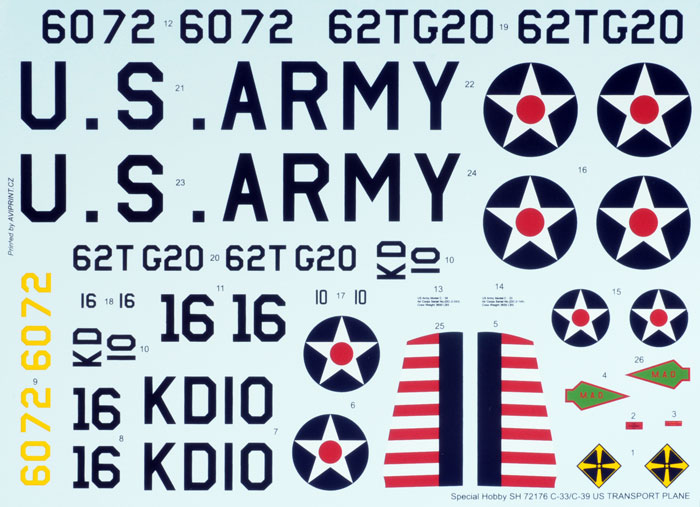
Four different decal options are offered.
-
C-33 4th Air Base Squadron USSAAC Sept 1938 All over Natural Metal finish with Aluminium doped fabric surfaces
-
C-33 Unknown unit 1940 Olive Drab over Neutral Grey
-
C-39 Middletown Air Depot Dec 1940 All over Natural Metal finish with Aluminium doped fabric surfaces
-
C-39 62nd Transport Group USSAAC Sept 1941 Olive Drab over Neutral Grey
While this is not a mainstream kit that will simply fall together, it is a sound kit with some simple extras that enable the modeller to produce another (and somewhat unusual) DC-2 variant that marks the transition to the larger and more famous DC-3/C-47.
Highly recommended to those with some experience in assembling limited run kits
Thanks to MPM / Special Hobby for
the review sample
Review Text Copyright © 2008 by Peter Mitchell
Images Copyright © 2008 by Brett Green
Page Created 7 July, 2008
Last updated
8 July, 2008
Back to HyperScale Main Page
Back to Reviews Page |
